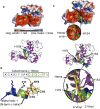In vitro reconstitution reveals major differences between human and bacterial cytochrome c synthases
- PMID: 33973521
- PMCID: PMC8112865
- DOI: 10.7554/eLife.64891
In vitro reconstitution reveals major differences between human and bacterial cytochrome c synthases
Abstract
Cytochromes c are ubiquitous heme proteins in mitochondria and bacteria, all possessing a CXXCH (CysXxxXxxCysHis) motif with covalently attached heme. We describe the first in vitro reconstitution of cytochrome c biogenesis using purified mitochondrial (HCCS) and bacterial (CcsBA) cytochrome c synthases. We employ apocytochrome c and peptide analogs containing CXXCH as substrates, examining recognition determinants, thioether attachment, and subsequent release and folding of cytochrome c. Peptide analogs reveal very different recognition requirements between HCCS and CcsBA. For HCCS, a minimal 16-mer peptide is required, comprised of CXXCH and adjacent alpha helix 1, yet neither thiol is critical for recognition. For bacterial CcsBA, both thiols and histidine are required, but not alpha helix 1. Heme attached peptide analogs are not released from the HCCS active site; thus, folding is important in the release mechanism. Peptide analogs behave as inhibitors of cytochrome c biogenesis, paving the way for targeted control.
Keywords: Heme; biochemistry; chemical biology; cytochrome c; cytochrome c biogenesis; heme attachment; post translational modification; synthases.
Plain language summary
From tiny bacteria to the tallest trees, most life on Earth carries a protein called cytochrome c, which helps to create the energy that powers up cells. Cytochrome c does so thanks to its heme, a molecule that enables the chemical reactions required for the energy-creating process. Despite both relying on cytochrome c, animals and bacteria differ in the enzyme they use to attach the heme to the cytochrome. Spotting variations in how this ‘cytochrome c synthase’ works would help to find compounds that deactivate the enzyme in bacteria, but not in humans. However, studying cytochrome c synthase in living cells is challenging. To bypass this issue, Sutherland, Mendez, Babbitt et al. successfully reconstituted cytochrome c synthases from humans and bacteria in test tubes. This allowed them to examine in detail which structures the enzymes recognize to spot where to attach the heme onto their target. The experiments revealed that human and bacterial synthases actually rely on different parts of the cytochrome c to orient themselves. Different short compounds could also block either the human or bacterial enzyme. Variations between human and bacterial cytochrome c synthase could lead to new antibiotics which deactivate the cytochrome and kill bacteria while sparing patients. The next step is to identify molecules that specifically interfere with cytochrome c synthase in bacteria, and could be tested in clinical trials.
© 2021, Sutherland et al.
Conflict of interest statement
MS, SB, DT, OM, NT, NP, AC No competing interests declared, DM, RK Washington University (Robert Kranz and Deanna Mendez, inventors) has applied for a provisional patent titled "PEPTIDE-BASED INHIBITORS OF CYTOCHROME BIOGENESIS". APPLICATION NUMBER: 63158593.
Figures





















Similar articles
-
Structural Insights into Mechanisms Underlying Mitochondrial and Bacterial Cytochrome c Synthases.Biomolecules. 2024 Nov 21;14(12):1483. doi: 10.3390/biom14121483. Biomolecules. 2024. PMID: 39766190 Free PMC article.
-
Human mitochondrial holocytochrome c synthase's heme binding, maturation determinants, and complex formation with cytochrome c.Proc Natl Acad Sci U S A. 2013 Feb 26;110(9):E788-97. doi: 10.1073/pnas.1213897109. Epub 2012 Nov 12. Proc Natl Acad Sci U S A. 2013. PMID: 23150584 Free PMC article.
-
Engineered holocytochrome c synthases that biosynthesize new cytochromes c.Proc Natl Acad Sci U S A. 2017 Feb 28;114(9):2235-2240. doi: 10.1073/pnas.1615929114. Epub 2017 Feb 14. Proc Natl Acad Sci U S A. 2017. PMID: 28196881 Free PMC article.
-
Cytochrome c biogenesis in mitochondria--Systems III and V.FEBS J. 2011 Nov;278(22):4198-216. doi: 10.1111/j.1742-4658.2011.08231.x. Epub 2011 Aug 2. FEBS J. 2011. PMID: 21736702 Review.
-
Mitochondrial cytochrome c biogenesis: no longer an enigma.Trends Biochem Sci. 2015 Aug;40(8):446-55. doi: 10.1016/j.tibs.2015.05.006. Epub 2015 Jun 11. Trends Biochem Sci. 2015. PMID: 26073510 Free PMC article. Review.
Cited by
-
Biogenesis of cytochromes c and c 1 in the electron transport chain of malaria parasites.bioRxiv [Preprint]. 2024 Oct 21:2024.02.01.575742. doi: 10.1101/2024.02.01.575742. bioRxiv. 2024. Update in: ACS Infect Dis. 2025 Apr 11;11(4):813-826. doi: 10.1021/acsinfecdis.4c00450. PMID: 38352463 Free PMC article. Updated. Preprint.
-
Genome-Scale Mining of Acetogens of the Genus Clostridium Unveils Distinctive Traits in [FeFe]- and [NiFe]-Hydrogenase Content and Maturation.Microbiol Spectr. 2022 Aug 31;10(4):e0101922. doi: 10.1128/spectrum.01019-22. Epub 2022 Jun 23. Microbiol Spectr. 2022. PMID: 35735976 Free PMC article.
-
Recent advances in microbial synthesis of free heme.Appl Microbiol Biotechnol. 2024 Dec;108(1):68. doi: 10.1007/s00253-023-12968-5. Epub 2024 Jan 9. Appl Microbiol Biotechnol. 2024. PMID: 38194135 Free PMC article. Review.
-
Investigation of the Molecular Mechanisms of the Eukaryotic Cytochrome-c Maturation System.Biomolecules. 2022 Apr 7;12(4):549. doi: 10.3390/biom12040549. Biomolecules. 2022. PMID: 35454139 Free PMC article.
-
Structural basis of membrane machines that traffick and attach heme to cytochromes.J Biol Chem. 2023 Nov;299(11):105332. doi: 10.1016/j.jbc.2023.105332. Epub 2023 Oct 10. J Biol Chem. 2023. PMID: 37827288 Free PMC article.
References
-
- Babbitt SE, San Francisco B, Mendez DL, Lukat-Rodgers GS, Rodgers KR, Bretsnyder EC, Kranz RG. Mechanisms of mitochondrial holocytochrome c Synthase and the Key Roles Played by Cysteines and Histidine of the Heme Attachment Site, Cys-XX-Cys-His. Journal of Biological Chemistry. 2014;289:28795–28807. doi: 10.1074/jbc.M114.593509. - DOI - PMC - PubMed
Publication types
MeSH terms
Substances
Grants and funding
LinkOut - more resources
Full Text Sources
Other Literature Sources
Miscellaneous

